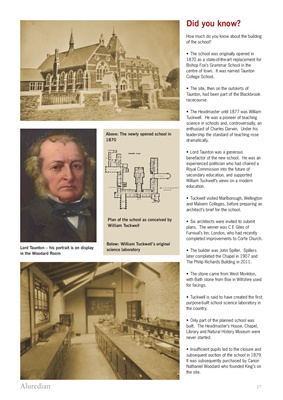
Aluredian 17
Did you know?
How much do you know about the building
of the school?
• The school was originally opened in
1870 as a state-of-the-art replacement for
Bishop Fox's Grammar School in the
centre of town. It was named Taunton
College School.
• The site, then on the outskirts of
Taunton, had been part of the Blackbrook
racecourse.
• The Headmaster until 1877 was William
Tuckwell. He was a pioneer of teaching
science in schools and, controversially, an
enthusiast of Charles Darwin. Under his
leadership the standard of teaching rose
dramatically.
• Lord Taunton was a generous
benefactor of the new school. He was an
experienced politician who had chaired a
Royal Commission into the future of
secondary education, and supported
William Tuckwell's views on a modern
education.
• Tuckwell visited Marlborough, Wellington
and Malvern Colleges, before preparing an
architect's brief for the school.
• Six architects were invited to submit
plans. The winner was C E Giles of
Furnival's Inn, London, who had recently
completed improvements to Corfe Church.
• The builder was John Spiller. Spillers
later completed the Chapel in 1907 and
The Philip Richards Building in 2011.
• The stone came from West Monkton,
with Bath stone from Box in Wiltshire used
for facings.
• Tuckwell is said to have created the first
purpose-built school science laboratory in
the country.
• Only part of the planned school was
built. The Headmaster's House, Chapel,
Library and Natural History Museum were
never started.
• Insufficient pupils led to the closure and
subsequent auction of the school in 1879.
It was subsequently purchased by Canon
Nathaniel Woodard who founded King's on
the site.
Above: The newly opened school in
1870
Lord Taunton - his portrait is on display
in the Woodard Room
Plan of the school as conceived by
William Tuckwell
Below: William Tuckwell's original
science laboratory